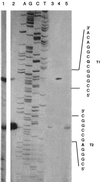Transcriptional control of the hydrogen cyanide biosynthetic genes hcnABC by the anaerobic regulator ANR and the quorum-sensing regulators LasR and RhlR in Pseudomonas aeruginosa
- PMID: 11092854
- PMCID: PMC94819
- DOI: 10.1128/JB.182.24.6940-6949.2000
Transcriptional control of the hydrogen cyanide biosynthetic genes hcnABC by the anaerobic regulator ANR and the quorum-sensing regulators LasR and RhlR in Pseudomonas aeruginosa
Abstract
Virulence factors of Pseudomonas aeruginosa include hydrogen cyanide (HCN). This secondary metabolite is maximally produced at low oxygen tension and high cell densities during the transition from exponential to stationary growth phase. The hcnABC genes encoding HCN synthase were identified on a genomic fragment complementing an HCN-deficient mutant of P. aeruginosa PAO1. The hcnA promoter was found to be controlled by the FNR-like anaerobic regulator ANR and by the quorum-sensing regulators LasR and RhlR. Primer extension analysis revealed two transcription starts, T1 and T2, separated by 29 bp. Their function was confirmed by transcriptional lacZ fusions. The promoter sequence displayed an FNR/ANR box at -42.5 bp upstream of T2 and a lux box centered around -42.5 bp upstream of T1. Expression of the hcn genes was completely abolished when this lux box was deleted or inactivated by two point mutations in conserved nucleotides. The lux box was recognized by both LasR [activated by N-(oxododecanoyl)-homoserine lactone] and RhlR (activated by N-butanoyl-homoserine lactone), as shown by expression experiments performed in quorum-sensing-defective P. aeruginosa mutants and in the N-acyl-homoserine lactone-negative heterologous host P. fluorescens CHA0. A second, less conserved lux box lying 160 bp upstream of T1 seems to account for enhanced quorum-sensing-dependent expression. Without LasR and RhlR, ANR could not activate the hcn promoter. Together, these data indicate that expression of the hcn promoter from T1 can occur under quorum-sensing control alone. Enhanced expression from T2 appears to rely on a synergistic action between LasR, RhlR, and ANR.
Figures







Similar articles
-
Characterization of the hcnABC gene cluster encoding hydrogen cyanide synthase and anaerobic regulation by ANR in the strictly aerobic biocontrol agent Pseudomonas fluorescens CHA0.J Bacteriol. 1998 Jun;180(12):3187-96. doi: 10.1128/JB.180.12.3187-3196.1998. J Bacteriol. 1998. PMID: 9620970 Free PMC article.
-
Iron regulation of the hcnABC genes encoding hydrogen cyanide synthase depends on the anaerobic regulator ANR rather than on the global activator GacA in Pseudomonas fluorescens CHA0.Microbiology (Reading). 2000 Oct;146 ( Pt 10):2417-2424. doi: 10.1099/00221287-146-10-2417. Microbiology (Reading). 2000. PMID: 11021918
-
Promoter specificity elements in Pseudomonas aeruginosa quorum-sensing-controlled genes.J Bacteriol. 2001 Oct;183(19):5529-34. doi: 10.1128/JB.183.19.5529-5534.2001. J Bacteriol. 2001. PMID: 11544214 Free PMC article.
-
Dual control of hydrogen cyanide biosynthesis by the global activator GacA in Pseudomonas aeruginosa PAO1.FEMS Microbiol Lett. 2001 Jun 12;200(1):73-8. doi: 10.1111/j.1574-6968.2001.tb10695.x. FEMS Microbiol Lett. 2001. PMID: 11410352
-
Mechanism, regulation, and ecological role of bacterial cyanide biosynthesis.Arch Microbiol. 2000 Mar;173(3):170-7. doi: 10.1007/s002039900127. Arch Microbiol. 2000. PMID: 10763748 Review.
Cited by
-
Volatile mediated interactions between bacteria and fungi in the soil.J Chem Ecol. 2012 Jun;38(6):665-703. doi: 10.1007/s10886-012-0135-5. Epub 2012 Jun 1. J Chem Ecol. 2012. PMID: 22653567 Review.
-
Pseudomonas aeruginosa Production of Hydrogen Cyanide Leads to Airborne Control of Staphylococcus aureus Growth in Biofilm and In Vivo Lung Environments.mBio. 2022 Oct 26;13(5):e0215422. doi: 10.1128/mbio.02154-22. Epub 2022 Sep 21. mBio. 2022. PMID: 36129311 Free PMC article.
-
Antimicrobial Weapons of Pseudomonas aeruginosa.Adv Exp Med Biol. 2022;1386:223-256. doi: 10.1007/978-3-031-08491-1_8. Adv Exp Med Biol. 2022. PMID: 36258074
-
Pseudomonas aeruginosa AlgR controls cyanide production in an AlgZ-dependent manner.J Bacteriol. 2009 May;191(9):2993-3002. doi: 10.1128/JB.01156-08. Epub 2009 Mar 6. J Bacteriol. 2009. PMID: 19270096 Free PMC article.
-
NirA Is an Alternative Nitrite Reductase from Pseudomonas aeruginosa with Potential as an Antivirulence Target.mBio. 2021 Apr 20;12(2):e00207-21. doi: 10.1128/mBio.00207-21. mBio. 2021. PMID: 33879591 Free PMC article.
References
-
- Arai H, Kodama T, Igarashi Y. Cascade regulation of the two CRP/FNR-related transcriptional regulators (ANR and DNR) and the denitrification enzymes in Pseudomonas aeruginosa. Mol Microbiol. 1997;25:1141–1148. - PubMed
-
- Bagdasarian M M, Amann E, Lurz R, Rückert B, Bagdasarian M. Activity of the hybrid trp-lac (tac) promoter of Escherichia coli in Pseudomonas putida. Construction of broad-host-range, controlled-expression vectors. Gene. 1983;26:273–282. - PubMed
-
- Belyaeva T A, Rhodius V A, Webster C L, Busby S J. Transcription activation at promoters carrying tandem DNA sites for the Escherichia colicyclic AMP receptor protein: organisation of the RNA polymerase alpha subunits. J Mol Biol. 1998;277:789–804. - PubMed
-
- Blumer C, Haas D. Mechanism, regulation, and ecological role of bacterial cyanide biosynthesis. Arch Microbiol. 2000;173:170–177. - PubMed
Publication types
MeSH terms
Substances
Associated data
- Actions
LinkOut - more resources
Full Text Sources
Other Literature Sources

